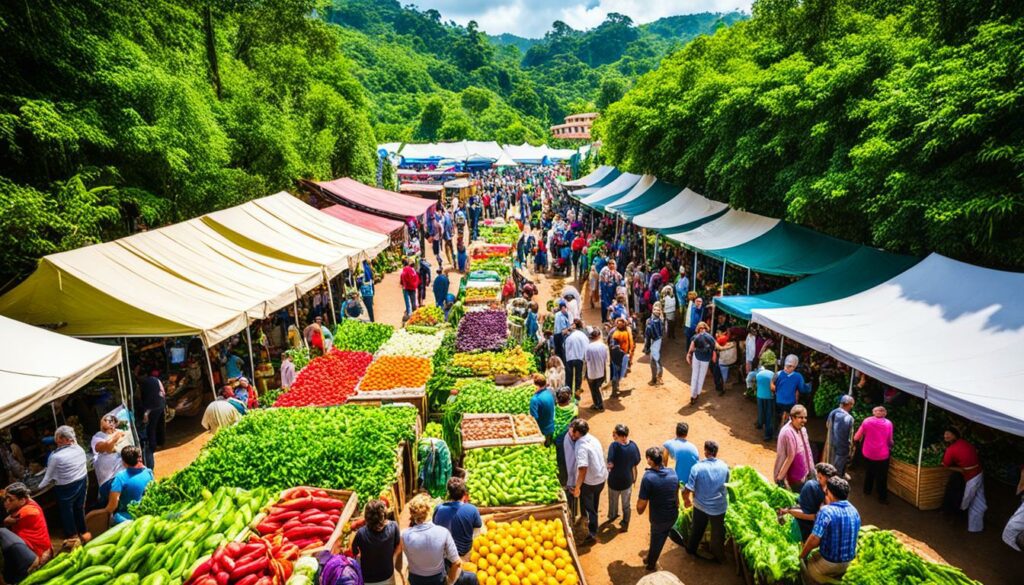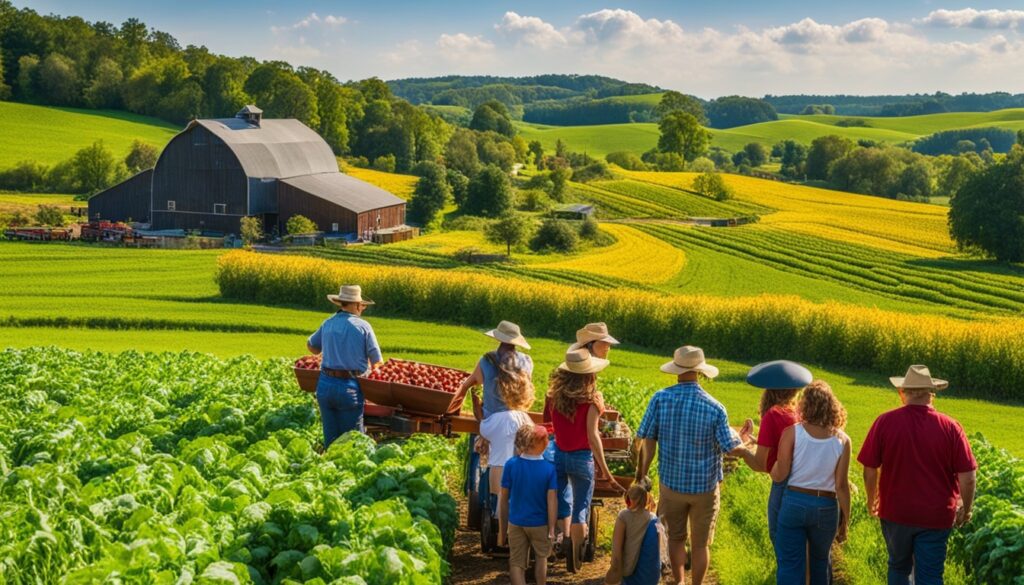Menu

Small farmers in North Carolina are showing that agritourism can make a big difference. By welcoming visitors to their farms, they are creating new economic opportunities. This shows how adaptable and innovative farmers can be.
Looking at successful agritourism projects offers great lessons. We see effective strategies and practices in action. Agritourism helps in rural growth and keeps agriculture strong. It also shows why farmers choose this path, including their commitment to farming.
I want to share inspiring stories of farmers turning their land into popular tourist spots. They turn their family farms into bustling businesses. They focus on innovation, entrepreneurship, and new income sources.
This approach transforms not just the farms but also the local areas. It breathes new life into communities while sharing the joys of farming.
Agritourism combines farming and tourism. It offers visitors unique experiences on farms, ranches, and other agribusinesses. This helps support farmers economically, while giving visitors a one-of-a-kind look at agricultural life.
Its growth is fuelled by activities such as staying at farms, going on hayrides, and picking your own produce. By entering this field, one can see how agritourism increases farm revenue and promotes sustainable rural tourism.
In agritourism, visitors take part in farm activities and learn about farming. It’s an enterprise that educates while generating income. The American Farm Bureau defines it as such: “an enterprise at a working farm, ranch, or agriculture plant conducted for the enjoyment of visitors that generates income for the owner.”
This shows that agritourism is about both fun for visitors and making money for farmers. Success comes from offering enjoyable and educational experiences.
Agritourism doesn’t just bring in extra money. It also boosts community spirit, helps rural areas grow, and keeps farming traditions alive.
These projects also draw city dwellers looking for real country life experiences. This builds a bridge between city and countryside ways of living. Agritourism not only boosts farm benefits and profits but also makes a region’s culture and economy stronger.
The Yatra-Farm Tourism Venture shows how agriculture and tourism can work together well. It’s a great model for sustainable farming tourism in North East India. It aims to help make farming more organic and to boost the income of farmers. Yatra combines visiting farms with staying in villages that focus on organic farming. This approach has proven very successful.

Sir Samir Ranjan started this venture in 2005. He convinced 500 farmers to switch to organic farming. Now, Yatra helps 125 farmers directly and provides jobs for young people. They offer tours in Assam and Nagaland’s organic villages. You can even stay on an organic tea farm and learn how tea is grown by getting your hands dirty. In Jorhat, there’s an organic farm with lots of cows and a big place where they make earthworm compost.
In the beginning, not all farmers were keen on organic farming. There were also issues with getting the word out about the tours. To tackle these problems, Yatra set up special organic model villages. Charaimari Organic Model Village is a good example. Now, young people there grow organic veggies to show how sustainable farming can be. To help farmers learn new, low-cost methods, Yatra started educational tours. Over 5600 farmers have learned better ways to farm. Yatra’s ‘Farm Preneur’ program, which helps school kids learn about running a farm, got recognized in 2015. It shows how important young people can be in teaching others about farming.
Yatra hasn’t just helped with organic farming locally. It’s gotten support from people all over the world, like tourists and those who work in farming. Near Kaziranga National Park, the Dhansirimukh Model Village lets visitors see nature up close. This adds a really special touch to the farm tours. Thanks to everyone working together, including farmer groups, the Yatra project has made a big difference. It shows how a mix of farming and tourism can really change things in rural areas for the better.
Agritourism is booming in North Carolina, especially for small farmers. It’s growing thanks to more people visiting farms and farmers branching out into new activities.
Many small farmers in North Carolina are adding agritourism to boost their income. Take Spring Haven Farm in Chapel Hill; it can get 600 guests a day, even school groups. And there’s Deans Farm Market in Wilson, run by James and Courtney Sharp. They offer hayrides, summer camps, and markets. This boosts their farm’s income and helps its success in agritourism.
Farmers’ success in agritourism relates to their personal and farm details. Their age, gender, and the size of their farm all matter, as does where they are. A big change is more farmers now work off the farm too. This shows it’s key to do different activities to compete well.
In 2014, a study found people in North Carolina like agritourism as it helps make more money in rural areas. The U.S. Census of Agriculture noted a big 35% increase in sales from 2012 to 2017. This shows more and more people are getting into these types of businesses.
| Year | Value of Agritourism Sales (in million $) |
|---|---|
| 2012 | 704 |
| 2017 | 950 |
Agritourism isn’t just about money. It also helps share culture and knowledge. Organizations like the North Carolina Agritourism Networking Association and the Agritourism Research Lab at NC State University, led by Dr. Carla Barbieri, are working hard. They support with research, push for laws that help, and help connect people in the business.
Overall, by mixing old farm ways with modern tourist needs, North Carolina is really standing out in the agritourism world. This helps the economy and brings local people more together.
The agritourism effort in Baramati District, Maharashtra, is changing how we look at Indian farming. It tackles the problems farmers face, like unstable incomes and how to farm sustainably. This project is a successful example. It shows how agritourism can work well, making money for farmers and encouraging eco-friendly travel.
Started by Pandurang Taware, agritourism in Baramati is making a big difference. A market survey in 2003 included 2,440 people. The first tours attracted 13,000 visitors in just 18 months. Over time, more than 628 farmers have earned Rs.58 crore together. The project made over Rs.50 crores before COVID, helping more than 600 farmers directly.

Agritourism brings many good things to Baramati. It gives farmers extra money, like how Krishna Padtare’s earnings went up five times. It also creates jobs and helps city and country people understand and like each other more. Tourists can enjoy visits to farms, see how crops are grown, learn about new ways to water plants, and find out about clean energy from the sun and wind.
The Baramati agritourism model has shown it can work well and keep getting better. A special feature is the 110-acre farm in Malegaon, with 65 acres for growing crops. This farm also has animals and makes silk. It’s a fun place to visit. At Rs.1000 per person, which includes two big meals, it’s a great deal for visitors and the farm.
The future for agritourism in Baramati looks bright. The area has a lot to offer, from its culture to its different landscapes, all good for farming. There’s still a lot of room to grow, which means more chances for jobs and helping the area’s economy. Baramati’s success in agritourism shows how new ideas can lead to good results and keep farming land green.
It’s key to know the critical success factors for agritourism. With a grasp of these, agritourism can have more income growth and success. Elements like diversification, entrepreneurship, marketing, community engagement, and training are crucial for successful agricultural tourism businesses.
Diversification boosts an agritourism business’s success. It means offering many services and experiences, attracting a wider audience. Entrepreneurship in agritourism means wearing the hats of both farmer and host. This approach not only grows the business but also makes it more personal for visitors.
Marketing and community engagement are vital. Using local cultures and traditions in marketing makes the experience genuine for visitors. Engaging the community helps in better support and visitor experiences. This close link between marketing and community can make a big difference in the success of agritourism businesses.
Farmer training and education are key in facing farm-tourism challenges. Learning about business planning, customer satisfaction, and market research is critical. These activities boost efficiency and ensure long-term success. For instance, global research underscores how continual learning is vital for agritourism success.
In Malaysia, the importance of these factors can be seen. The Ministry of Agriculture and Food Industry expects big growth in agritourism revenue from 2016 to 2019. Although 2020 saw a drop due to the Covid-19 pandemic, strong government support and effective policies helped Malaysia’s 144 agrotourism centres grow and stay strong.
Agritourism boosts local economies in rural areas. It brings in money from many places and makes new jobs. More and more people want special experiences in the countryside. This trend helps agricultural tourism grow and brings life back to these places.

Successful agri-tourism businesses see more money coming in. For example, Indiana makes about $6.7 billion a year from tourism. This number goes up by nearly 5 percent every year. These figures show how agritourism can really help the countryside profit.
Farmers find new ways to make money, like letting people stay on their farms and offering tours. This change adds to the beauty of the countryside. Thus, more people visit, spending money and helping the local economy grow.
Farm stays in agritourism create jobs. There’s work for tour guides, people working in hotels, and those leading workshops. Nearby places like restaurants and shops benefit too. This growth leads to a wave of new businesses and jobs in areas that need it most.
In places like the Indiana Uplands Wine Trail, several attractions gather. This strategy makes the region more appealing, bringing in more visitors. It opens doors for new local businesses, helping farms and the economy to thrive sustainably.
| Economic Impact Factor | Details |
|---|---|
| Revenue Generation | $6.7 billion annually in Indiana |
| Annual Tourism Growth | Nearly 5% |
| Rural Population Shift | -5.9% since 1990 |
| Convention and Visitors’ Bureaus | 51 out of 92 counties in Indiana |
The benefits of agritourism for farmers and communities are great. It helps make rural areas richer while offering fun and learning. These ventures truly improve life in the countryside, supporting growth and better living for all.
Agritourism business owners face many hurdles that can change how well their business does. Knowing and dealing with these issues is key to making *successful agritourism ventures* that help the local community and the environment.
Bad weather can really hurt a *profitable farm tourism venture*. Heavy rain or storms might stop farms from welcoming guests, which hits their income. At La Mota Ranch in Hebbronville, Texas, where lots of tourists visit every week, they have to watch the weather close to manage big groups of visitors.
Being worried about visitors getting hurt and the costs if they do also adds stress. Studies in Pennsylvania and New Jersey showed that high insurance and liability were big problems. Some states made laws to help with this, but business owners still have to make sure they follow local rules.
Getting the word out is vital for bringing in guests to *sustainable rural tourism spots*. Yet, marketing agritourism places is tough. New Jersey found marketing to be the greatest challenge. Using both old-style and new digital ways helps.
Places like Doepkens Farm in Maryland and Shuster’s Playtime Farm in Wisconsin found success with unique activities. They offer things like making flower arrangements or picking pumpkins to get more people interested. But reaching out to potential customers remains tough. Even in California, dealing with visitors was a big issue, showing that improving how we connect with customers is key.
Dealing with all these issues calls for careful planning, investments in marketing, and creative solutions. Working closely with local businesses and tourism groups also helps. They can offer vital support, ensuring the success and growth of agritourism in the long run.
I’ve looked at some impressive agritourism success stories. They show us why some farms do well. These cases are a great guide for others in agriculture tourism.
Agricultural tourism success comes from many angles. The best farms offer something special, like pumpkin picking in Wisconsin. They also add personal touches, like keeping the farm in the family.
Challenges like bad weather or safety risks are tackled smartly by these farms. They charge for activities and know their visitors well. This has made La Mota Ranch in Texas a popular spot.

Innovation and tech are key in agritourism. Using social media, farms reach more people. Posting fun content online can really get visitors interested.
New farming tech, like online booking, makes things run smoother. These innovations are vital for a fresh agritourism experience and staying ahead in the field.
| Farm Name | Unique Attribute | Visitor Engagement |
|---|---|---|
| La Mota Ranch | Bus Tours | $60 per person |
| Doepkens Farm | Chrysanthemum Murals | Increased Halloween visits |
| Shuster’s Playtime Farm | Pumpkin Picking | Expanded from 1/3 acre to 7 acres |
These cases show how agritourism is always changing and growing. With special farm features, community support, and modern tech, agritourism helps both farmers and visitors.
The global agritourism sector has a wide range of models, reflecting local traditions and climates. By looking at successful agritourism in Europe and Asia, we learn how to make farm stays work well.
In Italy, agritourism is an essential part of farming, with over 25,000 farms involved as of 2021. The number has grown by over 40% since 2007, showing rapid progress. These farms do various activities. For instance, 20% only provide lodging and 36% offer both lodging and food.
Many also have fun options like horseback riding and hiking. This mix has really boosted the revenue of agritourism in the area.
The area of Tyrol–South Tyrol–Trentino in Italy stands out for its high agritourism activity. It mixes traditional and new activities to keep farms going and help the local economy. By using local culture and scenic beauty, they attract visitors. This helps make their farm stays a success.
In Asia, more specifically Northeast India, the Yatra-Farm Tourism Venture promotes organic farming. It faced challenges at first. But it now trains lots of farmers in sustainable and low-cost farming. This effort has significantly increased local income and supported organic farming.
Agritourism adapts well to different local settings. For example, the Trentino–South Tyrol area of Italy uses its agricultural history and natural beauty to bring in tourists. This strategy has grown their agritourism economy by attracting more visitors.
In Italy, many farms offer more than just a place to stay. About 59% of them provide extra activities. These activities help visitors connect more with the farm and its surroundings. Including tasting local food and products with lodging shows how well traditions can enhance visitors’ experiences.
In India, agritourism focuses on local farming methods that suit the environment. The Yatra-Farm Venture is a great example. It has helped farmers deal with financial issues and opened new income paths. This shows the importance of making agritourism plans that fit the local area and are environmentally and economically sound.
The analysis underlines how important it is to make each agritourism model fit its unique local environment and culture. By doing so, farmers can significantly boost their income from tourism. It also helps ensure that the farms can sustain their success over time.
| Region | Unique Features | Economic Impact |
|---|---|---|
| Italy (Tyrol–South Tyrol–Trentino) | Diverse activities, integration of food service and lodging | Increased revenue, enhanced market visibility |
| India (Yatra-Farm) | Promotion of organic farming, model villages | Boost in local organic farming, community development |
This study of global agritourism models shows their power. They can help farms grow financially, support lasting environmental practices, and make farm stays a hit with visitors. This is good for the local economy too.
Government policies are key to making agricultural tourism businesses thrive. They do this by giving vital resources and setting clear rules. Thanks to the government’s active role, agritourism grows in a way that helps rural areas and their economies.

Subsidies and financial help are very important for making rural tourism more profitable. Governments can push farmers to start agritourism by giving them money. This move boosts farm incomes and makes rural communities stronger. The USDA found that this kind of help is a big reason many agritourism places do well in the U.S.
Farmers need good training and skills to run their agritourism well. Efforts by the Cooperative Extension System in the U.S. show how important this is. Good training and education help farmers use the best methods, solve problems, and find new chances in tourism.
To sum up, government policies, such as subsidies and training, are vital for agritourism success. They improve farm incomes and make rural tourism stronger. This helps farmers and their communities a lot.
Innovative agritourism practices are changing how we see rural areas. They mix eco-tourism and green practices. This allows visitors to get close to farm life. It also helps protect the environment. By offering tours and stays at farms, it boosts experiences for visitors and income for farmers.
Many agritourism ventures focus on being eco-friendly and sustainable. Farmers use organic methods and save native plants. This is in places like Brazil, with lots of farms protecting nature. Italy has over 20,000 spots where tourists can see real farm life. These steps help farms make more money and care for the planet.
| Country | Agritourism Initiative | Focus |
|---|---|---|
| Brazil | Preservation of Native Vegetation | Eco-Tourism |
| Italy | Agriturismos | Authentic Pastoral Experience |
| Philippines | Pineapple and Exotic Fruit Farms | Sustainable Practices |
| Hawaii | Organic Farms | Environmental Stewardship |
Educational tours and stays on farms are key in agritourism. They teach visitors about farming and the local food scene. Taiwan’s leisure farms and Grenada’s spice farms are good examples. Here, guests join in on farming tasks. This personal touch, like at farmers’ markets, makes people value local food more.
Tourism combined with learning about farming makes guests respect it more. Teams working together with local tour groups is crucial. This helps agritourism to keep improving and be successful everywhere.
The agritourism industry is ready to grow a lot. This growth will come from new technology and what people want when they travel. It’s changing how we see trips to the countryside. And it’s making new chances for people who run agritourism places around the world.

New technology is set to change the face of agritourism. Think about people being able to explore farms through virtual reality at home. It could make more people want to visit in real life. Then, there’s precision farming. It lets farmers use data to do their work better. These tech advances make visiting farms cooler and help farmers work smarter. This means better times for people on trips and more money for farm businesses.
People’s tastes in countryside trips are getting more specific. They want to do real stuff and get to know local ways. This has brought on a love for eating local foods, buying homemade items, and being eco-conscious. The result is more demand for agritourism that matches these wants. It’s a great chance for agritourism owners. They can welcome all kinds of visitors, from young families to older explorers, looking for unique moments.
Recent discussions add more to this story. A talk about the Caribbean showed how visitors now want different things and how combining farming and tourism can be good. Shauna Brandon talked about needing better local products to meet new wants. And Carlota Morales praised a coffee farm tour in Costa Rica for showing how agritourism can be good for communities.
Enrique Hennings underlined agritourism’s part in joining country and city life, improving local goods, and keeping traditions alive. Clearly, upcoming trends in agritourism are all about looking after culture and making sure it’s good for the economy, too.
| Region | Focus Areas | Market Opportunities |
|---|---|---|
| North America | Direct-market Agritourism, Event and Recreation | High demand for experiential travel |
| Europe | Experience and Education Agritourism | Strong interest in sustainable tourism |
| Asia-Pacific | Eco-Tourism Practices | Rapidly growing market |
| South America | Community-led Agritourism | Enhanced focus on cultural preservation |
| Middle East and Africa | Innovation and Technology Integration | Emerging tourism destinations |
Officials and experts discussed these trends in Central America and the Caribbean. They talked about the big tourism boost after the pandemic. And they stressed how important new technology is for agritourism to grow.
To sum up, agritourism’s future looks sunny. It’s all about tech and what holidaymakers really want to see and do. Embracing these trends will mean more fun, green practices, and better business in agritourism.
I’ve explored successful agritourism ventures worldwide. This field is promising, focusing on sustainability and community. It shows a new way in rural tourism. Lessons from various places stress the role of good location, happy customers, smart use of resources, effective marketing, and government backing for success.
In Maharashtra and Goa, 45 agritourism operators shared their insights. Location’s beauty and nearness to towns stood out. So did keeping visitors happy, impacting 13.9% of success. Managing what you have well is key. Using resources fully, investing wisely, offering many activities, and having skilled staff are vital.
Summing up, agritourism’s future looks bright. By using good locations, making visitors happy, and smart resource use, farmers can succeed. They must keep learning and sharing to grow. With a spotlight on innovation, tech, and authentic experiences, achieving long-term success is possible.
A few good examples are Yatra-Farm Tourism in North East India, small farms in North Carolina, and the Baramati project in India. They show different ways to do agricultural tourism and succeed.
Agritourism mixes farming with tourism for business. It lets visitors learn about farming while giving extra money to farmers. This boosts farm incomes and their public image.
It helps farms make more money and opens up new paths for income. It also connects farmers with their local community and keeps old farming ways alive. This refreshes rural areas, making them more lively.
The project initially struggled with farmers’ doubts and how to market. It worked by setting up model villages and educational tours. This led to more organic farming and a famous organic brand in the area.
In North Carolina, agritourism is a big deal for small farmers. It depends on farm size, where the farm is, the farmer’s age and more. It’s all about mixing farm work with other jobs and keeping a strong family farm.
Agritourism adds cash for Baramati farmers and jobs in the area. It also brings people from cities to experience rural life. This has helped raise incomes and look after the environment better.
Success comes from mixing up what you grow, running your farm like a business and being welcoming, marketing well, talking with the community, and teaching the farmers well.
Agritourism boosts money for farms and nearby places. It creates jobs on farms and in nearby shops. This helps the economy grow better.
They deal with bad weather, worry about accidents, and how to find customers. By planning well, focusing on good marketing, and coming up with ideas, they can make their ventures safe and successful.
Every place has its own way of doing agritourism, shaped by local traditions and the land. Models in Europe and Asia are quite unique but still bring good things for everyone involved.
Government help is key in making agritourism grow. They give support, money, and teach people how to do it. This makes farms more profitable and keeps rural areas vibrant.
Nature-friendly and learning-based tours are the future, like visits to organic farms. People can stay on farms, enjoying and learning about farming life. It’s a way to have fun and support the planet.
Agritourism is getting more digital and aiming for greener farming. People want to see real farming and help the environment. With new technology, farms can offer fresh and memorable experiences.